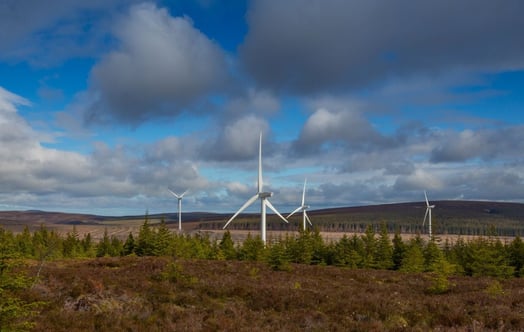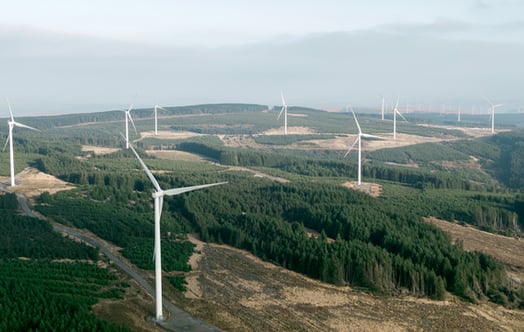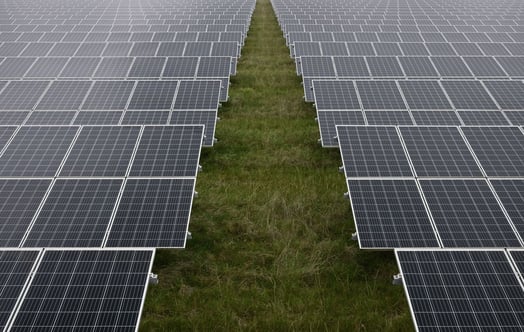
Turning wind turbines..... into skis, insulation and solar farms
- Wind turbine blades from a decommissioned wind farm will be turned into skis, insulation and materials for solar farms
- 90% of a turbine is already recyclable, but blades are made from composite materials and are more difficult to recycle
- Swedish developer Vattenfall will recycle all turbine blades by 2030, with a ban on sending blades to landfill already in place.
Game-changing trials to recycle 84 turbine blades from a decommissioned wind farm will see them re-used to produce sports equipment like skis and snowboards, insulation materials, and components for solar farms.
Although 90% of a wind turbine is already recyclable and most components – such as the tower, gearbox components and generator – are easy to reuse and recycle, turbine blades are made of composite materials and are therefore more challenging to recycle.
Currently there are no options for large-scale re-use of turbine blades. But a new approach using blades from Vattenfall’s decommissioned Irene Vorrnik1 onshore wind farm in the Netherlands could ultimately lead to a second life for the more than 30,000 blades currently generating clean electricity in the UK.
There are 11,092 operational2 onshore and offshore wind turbines in the UK today with an installed capacity of 24,632.540 MW – enough to power up to 18,215,882 homes annually2. That number will grow dramatically over the next decade as the country races to meet the Government’s target of 50GW of installed offshore wind capacity by 2030.
The 28-turbine Irene Vorrink site will be the largest wind farm to date from which blades will be fully recycled or reused. As the blades are taken down, they will be cut into smaller pieces suitable to be transported to the recycling facility.
Norwegian recycling company Gjenkraft AS will use some of the blades to produce recycled fibers, synthetic oils and gas, which could then go on to become skis, snowboards and insulation materials.
The LIFE CarbonGreen Consortium will research new ways of re-processing blades, with a particular focus on re-using them in the construction of solar farms. Educational institute ROC van Amsterdam will also receive two blades to use as a training tool for future wind turbine technicians.
Vattenfall has set ambitious targets to recycle at least 50% of all decommissioned turbine blades by 2025, rising to 100% by 2030. Sending blades to landfill has already been banned by the developer, which operates 10 onshore and offshore wind farms in the UK.
Danielle Lane, Country Manager for Vattenfall in the UK, said:
“In the future, we could be using wind farm blades to keep our homes warm, exercise and even to build solar farms. These new research projects could provide the answers we’ve been searching for as an industry, opening up exciting possibilities to deal with the challenge of recycling turbine blades.”
Eva Philipp, Head of Environment and Sustainability at Vattenfall’s’ Business Area Wind, said:
“As the wind industry continues to grow to provide fossil-free energy across the globe, Vattenfall is committed to supporting a circular economy which reduces environmental impacts throughout the product lifecycle.”
Notes to editors
Irene Vorrink Wind Farm was commissioned in 1997. The 28 turbines had an installed capacity of 16.8 MW
Source: RenewableUK
Vattenfall operates 10 wind farms in the UK with a total installed capacity of 1,069MW. Find out more here.
About Gjenkraft AS
Our recycling technology is based on a variation of the pyrolysis process which enables us to recover glass and carbon fibres, synthetic fuels and carbon from the waste. The target market is the wind industry, mainly wind turbines blades, and other industries, i.e. boats, automotive, aviation, and construction. The innovative process of thermal treatment of composite waste designed by us is the answer to the market demand for sustainable waste treatment services. Our target customers are companies that adapt their waste management policy to EU and EEA regulations and circular economy policy. Thanks to our comprehensive approach we can secure added value for both upstream and downstream customers.
Web page: https://www.gjenkraft.com/
About LIFE CarbonGreen
The CarbonGreen project, co-funded under the LIFE20 ENV/NL/000200, is bringing a new solution able to transform secondary raw materials, like the wind turbine blades, into products or intermediates. The technology can process all kinds of material streams. In contrast to current methods the process only uses electricity and has no chemical consumption, other than some additives, ultimately producing basic valuable compounds. Finally, these CarbonGreen products can be recycled again, ensuring circularity and zero waste.
“Thanks to our innovations, we can support the wind industry in its ambitious goals towards a circular value chain” – says Mr. Ludwin Daal from Blue-Expert, the start-up that is coordinating the CarbonGreen Consortium. The process can create new high-value products like components for solar farms or activated carbon which can be used to purify our waters, air, and soil.
Web page: www.carbongreen.eu



